new posts in all blogs
Viewing: Blog Posts Tagged with: children&apos, Most Recent at Top [Help]
Results 26 - 50 of 76
How to use this Page
You are viewing the most recent posts tagged with the words: children&apos in the JacketFlap blog reader. What is a tag? Think of a tag as a keyword or category label. Tags can both help you find posts on JacketFlap.com as well as provide an easy way for you to "remember" and classify posts for later recall. Try adding a tag yourself by clicking "Add a tag" below a post's header. Scroll down through the list of Recent Posts in the left column and click on a post title that sounds interesting. You can view all posts from a specific blog by clicking the Blog name in the right column, or you can click a 'More Posts from this Blog' link in any individual post.

By:
Stacy Whitman,
on 10/24/2011
Blog:
Stacy Whitman's Grimoire
(
Login to Add to MyJacketFlap)
JacketFlap tags:
science fiction,
young adult literature,
publishing,
fantasy,
paranormal,
children's literature,
joseph bruchac,
tu books,
tu,
karen sandler,
tankborn,
wolf mark,
Add a tag
Nook readers, you can now find almost all of our books there. Tankborn and Wolf Mark are up now, and Galaxy Games: The Challengers will be up soon. Also, for those of you on iPads or other Apple devices, all three books are up (I linked Galaxy Games: The Challengers before).
Here are your links!
Nook

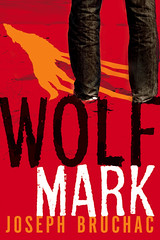
iTunes/iBooks


Originally published at Stacy Whitman's Grimoire. Please leave any comments there.

By:
Stacy Whitman,
on 10/24/2011
Blog:
Stacy Whitman's Grimoire
(
Login to Add to MyJacketFlap)
JacketFlap tags:
publishing,
children's literature,
joseph bruchac,
tu books,
tu,
greg fishbone,
karen sandler,
tankborn,
wolf mark,
galaxy games,
Add a tag
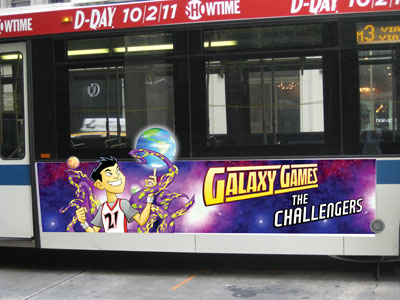
Galaxy Games gets cross town treatment
Let’s take a look at all the things happening online for the launch of Tu’s first three books. First of all, see what our publisher Jason Low would do if we had a million dollars to promote our first three books. Too bad we’re not millionaires!
The Challengers
First up, The Challengers, book 1 of the Galaxy Games series. To celebrate, author Greg Fishbone is currently on a month-long blog tour that includes a game that readers can play along, finding puzzle pieces to fit together and win prizes. To find out more on how to play the game, go to http://galaxygam.es/tour/ and find out what puzzle piece they’re on. Note that there’s also a giveaway—poke around on the site to find more ways to enter!
You can also follow Greg on Twitter, like the Galaxy Games series on Facebook, or like Greg on Facebook for more news as it happens.
Here’s what Publishers Weekly had to say about Galaxy Games:
Complemented by Beavers’s comic book style artwork, Fishbone’s narrative is ripe with kid-friendly humor—i.e., Earth’s radio and TV transmissions are picked up by the toilets on the Mrendarian ship—and many of the plot twists could be straight from the ‘what if’ imaginings of a fourth-grade classroom. Though Fishbone clearly sets up the next book, he gives Tyler enough of a victory to leave readers satisfied. —Publishers Weekly
Wolf Mark
Joseph Bruchac, author of Wolf Mark, recently shared a video on YouTube talking about why he wrote the book, his inspiration, and other thoughts on this exciting suspense-filled paranormal thriller. Check it out!
Here’s what Publishers Weekly and Kirkus have to say about Wolf Mark, too:
Bruchac (Dragon Castle) delivers a fun twist on werewolf stories mixed with some mad science and espionage. . . . Bruchac adeptly incorporates characters of various heritages: Luke is Native American; his best friend/crush, Meena, is Pakistani; and the Sunglass Mafia a group of students who are more than they seem are from eastern Russia. Luke also possesses a hefty amount of cultural and political awareness to go with his combat and espionage expertise, which serve him well. . . . [T]he action and Luke’s narration carry the book nicely. —Publishers Weekly
A loner teen finds himself caught up in a paranormal paramilitary threat but he has both untapped personal resources and some unlikely allies to help him out. Ever since his mother died, his father-a sometime Special Ops-type agent who happens to be of Native American descent-has been worse than useless. Lucas just concentrates on doing well in school and mooning over the beautiful daughter of one of the Pakistani scientists working at the new Romanian-owned top-secret facility in town. He goes out of his way to avoid the Sunglass Mafia, a bunch of unusually pale Russian students. But when his father is kidnapped and gives him a coded message by
Reader reactions are so subjective. One person might think there’s not nearly enough worldbuilding in a book (“give me more! MORE!”) and another might say of the exact same book that what worldbuilding there is was way too confusing (“I couldn’t keep all those made-up words straight!”).
So how do you, as the author, balance the needs of such a wide range of readers when you’re working in a complex world that needs development? And how do you balance the need to establish your characters, setting, and plot with the need to spool out information to your reader to intrigue them rather than confuse them?
This is a question that pretty much every author and editor of speculative fiction struggles with, particularly because we, as veterans of the genre, are already more comfortable with a lot of worldbuilding jargon than your average teen reader, particularly teen readers whose preference for fantasy runs more toward the contemporary paranormal variety. There are a number of reasons why I think Twilight was so popular on such a broad scale, but one of the biggest ones was the relatability of the situation. So what if you’ve never had a vampire show up at your high school? It could happen!
Think about all the really big fantasy hits of the last few years in children’s and YA fiction: Harry Potter, Percy Jackson, Twilight, Hunger Games. Of these books’ beginnings, only The Hunger Games is all far that outside the everyday experiences of your average young reader, and even The Hunger Games starts with a relatable situation—a coal mining family lives in a desperate situation and must hunt for food; while most kids who would have access to The Hunger Games don’t live under a despotic regime, it’s plausible that it could happen in the real world. Harry Potter and Percy Jackson are ordinary kids going to school, living somewhat normal lives (even if abusive ones, in the case of Harry) before their worlds change with the discovery of magic. Their starting point is relatable.
What this means is that readers of Harry Potter, Percy Jackson, and Twilight figure out the world alongside the main character. Information is spooled out as the character needs it, so the reader doesn’t have to absorb everything at once. This is a low bar for entry, not requiring much synthesis of information.
What about Hunger Games? Now it gets a little tougher. Suzanne Collins starts out with a perfectly relatable (if a tiny bit cliche) situation, the main character waking up and seeing her family. We get some exposition on Katniss’s family and the cat who hates her. But it becomes non-cliche by page 2, when we learn about the Reaping. Ah! What’s the Reaping, you ask? We don’t know yet. Now the bar for entry is raised. There is a question, the answer for which you’re going to have to read further to find out. The infodumpage level is low, but there is still some exposition in the next few pages, letting us know that Katniss lives in a place called District 12, nicknamed the Seam, and that her town in enclosed by a fence that is sometimes electrified—and which is supposed to be electrified all the time.
Collins’s approach to spooling out a little information at a time is to explain each new term as she goes, but some readers think that feels unnatural in a first person voice because the narrator would already know these things, so why is she explaining them to the reader? It depends on the story, in my opinion—Collins makes it work because of how she crafted Katniss’s voice. It is a very fine line to walk—I can’t tell you how many submissions I’ve gotten that start out with, “My name is X. I am Y years old. I live in a world that does Z,” an obvious example of how this approach becomes downright clumsy when
I’m going through a big stack of submissions that have been languishing for a while (and if you submitted a partial before Sept. 1 and don’t get a request for a full manuscript by the end of the week, you’ll know the answer is a no thanks). I’m on the lookout in particular for a book that will appeal to middle-grade girls, and I’m having a bit of a frustrating time of it. Mostly because humorous middle-grade voice seems to be a hard one to nail, and so many of the submissions in my pile seem to be going for a humorous bent.
Voice is the one thing that I don’t feel, as an editor, that I can fix. It’s too intrinsic to the art, too personal, something that has to be worked on before it comes across my desk. And a humorous voice? Even harder to shape as an editor. I completely appreciate how tough humor is just in general. It’s very subjective. So something that makes me giggle madly might not tickle someone else’s funny bone.
However, there is also a certain voice that I can only describe as “trying too hard.” The intended humor is super-goofy, overexplaining the jokes and losing the reader in the process. It feels too self-conscious, like the character is watching herself too closely instead of living her life. Humor should come, in my opinion, as a side effect of situations that happen to be a little goofy, rather than forced out of something the character finds funny, which is harder to translate into reader laughs. Thus, I personally think it’s really hilarious that Tyler Sato gets a killer asteroid named after him because, coincidentally, his cousins happened to name a star after him. But Tyler Sato himself doesn’t find it all that funny.
Part of the problem is that self-consciousness can sometimes work in YA, at least more than middle grade, because teens are more likely to notice things comment on them in a snarky way. Middle graders aren’t expected to be jaded just yet. But it’s not just that. Have you ever noticed that whenever, say, Stephen Colbert loses his deadpan, the joke loses a little something? Part of the hilarity is in the deadpan delivery. And we also have to acknowledge that not everyone is a humor writer—and that’s okay. Sometimes a book can be better when it’s not trying so hard for the laughs.
If you are writing humor, my only suggestion for improving your craft is to read writers who make it work, like Lisa Yee, Michael Buckley, and Tu’s own Greg Fishbone.
What I’d really like to see in my submission pile, though, as far as middle-grade books are concerned, is not necessarily humor—after all, we’ve got the hilarious Galaxy Games coming out this month already; go buy it! or read an excerpt!—but rather straight-on fantasy, science fiction, and mystery for middle-grade readers of both genders, but particularly girls because I don’t have much on my list for middle-grade girls right now. I’d love to see something more along the lines of Shannon Hale’s books for middle grade readers (one of my favorite books of all time is her Book of a Thousand Days, set in a Mongolia-like world): adventure and coming-into-her-own (not necessarily coming-of-age, which is more of a YA thing; would love such YAs, but I’m talking MG here right now). I also wouldn’t mind something along the lines of Michael Buckley’s The Sisters Grimm, while noting that even though the book is

By:
Stacy Whitman,
on 10/24/2011
Blog:
Stacy Whitman's Grimoire
(
Login to Add to MyJacketFlap)
JacketFlap tags:
dystopia,
science fiction,
young adult literature,
publishing,
children's literature,
tu books,
tu,
karen sandler,
tankborn,
Add a tag
 We’ve been getting some really great reviews in for Tu’s fall books, so I figured I’d start by sharing a few that have come in recently for Tankborn by Karen Sandler. I’m just quoting a few parts of each review, so follow the links to the blogs below for the whole reviews! (And this isn’t even all of them—the post was getting too long. Thanks so much to everyone who has read it so far, and of course I look forward to reading more reviews as others get a chance to read it.)
We’ve been getting some really great reviews in for Tu’s fall books, so I figured I’d start by sharing a few that have come in recently for Tankborn by Karen Sandler. I’m just quoting a few parts of each review, so follow the links to the blogs below for the whole reviews! (And this isn’t even all of them—the post was getting too long. Thanks so much to everyone who has read it so far, and of course I look forward to reading more reviews as others get a chance to read it.)
Science fiction is definitely experiencing a renaissance. . . . Sandler deftly weaves strands of race, privilege, politics, greed, and romance into a fascinating culture. The young protagonists are very real and exhibit great strength of character.
—Diana Tixier Herald of Genrefluent
Oh, my goodness, is that a person of color on the cover of a YA novel? It is! And she’s beautiful, and Sandler is awesome for writing about women of color in a genre that is inundated with stories about white teenagers, their special powers and their absent parents. And that cover is beautiful by itself with all that green and blue.
<snip>
Kayla’s assignment is in a large trueborn house, where, as soon as she arrives, she’s called a jik twice. But here’s where the real story starts.
Here, Kayla is brought face-to-face with Devak, the trueborn boy who saved her brother earlier in the book. She’s there to care for his great-grandfather, but Zul Manel has other things in store for her. The best part of this book is watching Devak go from idly racist to enlightened. Sometimes it’s hard for us to understand intense racism and hate, but I can see how Devak’s insulated trueborn upbringing could make him blind to the GENs’ plight. ”It’s for their own good”, “they like the way things are”, “resetting and realigning a GEN is in their best interest” are all common tropes that Devak has has drilled into his head since he was a child. It’s like some sort of benevolent slavery, with “benevolent” having a very flexible definition. Seeing Kayla changes him, and when he meets Mishalla, he doesn’t even blink.
Mishalla is vital to the story as well, though she’s not nearly as interesting as Kayla. Mishalla is in a creche, taking care of ostensibly orphaned lowborn children. She’s frightened and easily cowed for the most part, but that just comes with being a GEN. I think the plot needed Mishalla to stay where she was for the story to be furthered, but Mishalla really is important. She overhears vital information and puts her life on the line to save children who, in a few years, would look right through her or call her a jik. That’s courage.
This book is bittersweet. I enjoyed it thoroughly, but it made me a little sad at the end. I wish this one was a series! Look for it next month!
—Tina at Nose in a Book, Head in a Blog
It is rare that I come across a book that I would love to teach. I’m not headed out to be a teacher, or to make lesson plans of any sort, but there have been a few times that I’ve come across a book so perfectly written that it is made to be in a classroom. A book that has lessons that need to be taught with a plot that can capture the heart of a high school student set against reading. Tankborn is on
Look what I just saw, right at eye level, at the Union Square B&N!
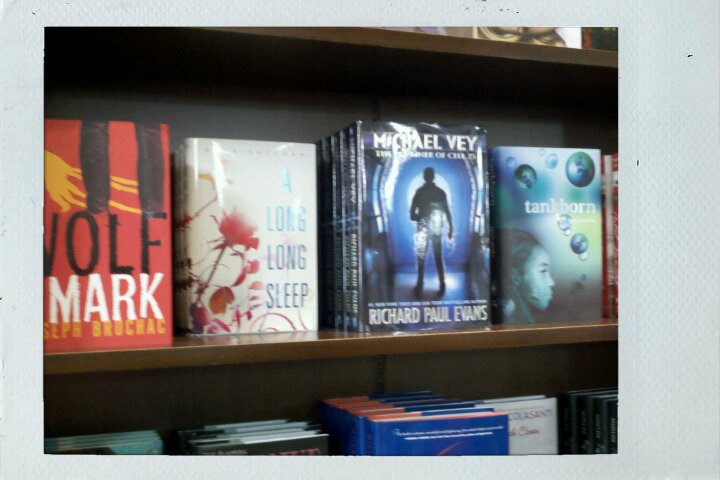
It’s a bit early still—these are September releases—but it still makes me giddy to see them!
Now it’s your turn! Go look for them! Go buy them! (And if your preferred bookseller doesn’t yet have them or Galaxy Games: The Challengers on sale yet, let them know you’re highly anticipating them and ask them to be sure to order them in.)
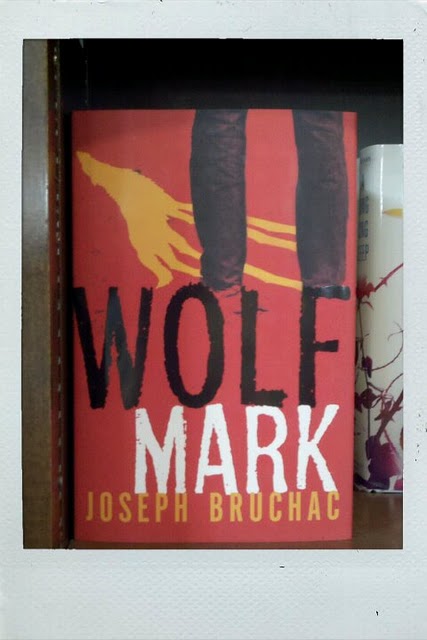
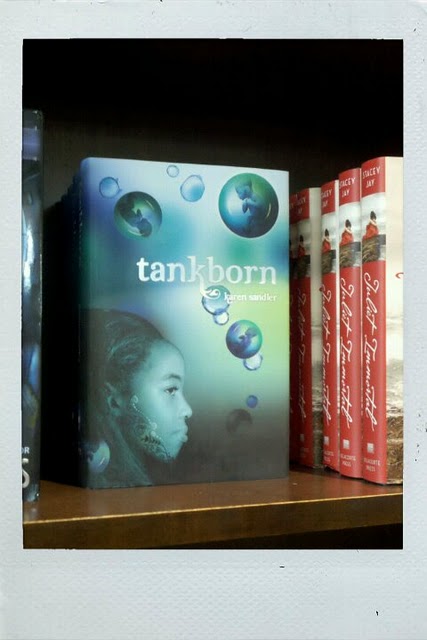
Originally published at Stacy Whitman's Grimoire. Please leave any comments there.
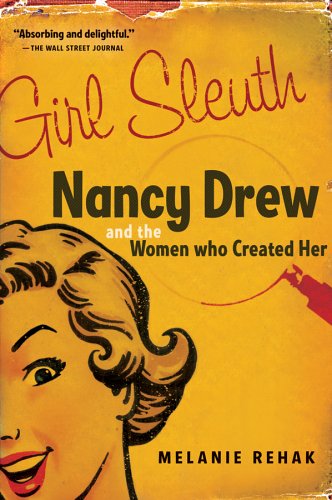 My latest read is a departure from my normal fiction fare: Girl Sleuth: Nancy Drew and the Women Who Created Her. We start off getting some biographical details of Edward Stratemeyer, who headed the Stratemeyer Syndicate—which, far from being the organized crime ring the name sounds like, was the company that created Nancy Drew back in the 20s.
My latest read is a departure from my normal fiction fare: Girl Sleuth: Nancy Drew and the Women Who Created Her. We start off getting some biographical details of Edward Stratemeyer, who headed the Stratemeyer Syndicate—which, far from being the organized crime ring the name sounds like, was the company that created Nancy Drew back in the 20s.
Stratemeyer got his start in the late 1800s writing for penny dreadful magazines, the newspaper equivalent of dime novels for kids. The first chapter goes into a brief history of St. Nicholas magazine, and here’s the point of my post today, a quote from chapter 1:
The very existence of so many papers for children was a relatively new phenomenon. Most of the early nineteenth-century children’s magazines had been connected to religious orders of one sort or another . . . and all of them had a tendency to be didactic and somewhat dull. But by the middle of the century, secular papers that took as their task merely the amusement of children were beginning to make their presence felt. . . . Just prior to its [St. Nicholas's] launch, Mary Mapes Dodge—St. Nicholas’s editor and the author of the international children’s bestseller Hans Brinker; or, The Silver Skates (1865)—announced that, in something of a departure, the magazine would contain “no sermonizing . . . no wearisome spinning out of facts, nor rattling of the dry bones of history . . . the ideal child’s magazine is a pleasure ground.”
That last part is an important one, and one to remember for those writing children’s books. “The ideal child’s [book] is a pleasure ground.” Of course, that doesn’t mean that we won’t absorb facts along the way or learn a little history as we set off on adventure, but the most important thing to remember when spinning your tales is that it’s about entertaining your readers. If there’s a lesson to be learned, it will be natural to the course of the story because it springs from character growth, not the other way around.
Originally published at Stacy Whitman's Grimoire. You can comment here or there.
 Tankborn received its first press review from Kirkus!
Tankborn received its first press review from Kirkus!
Advanced genetic engineering and upsettingly plausible caste oppression keep pages turning in this futuristic science fiction tale… A good option for science-fiction fans interested in genetic engineering, rebellion and class issues.
Originally published at Stacy Whitman's Grimoire. You can comment here or there.

By:
Stacy Whitman,
on 7/5/2011
Blog:
Stacy Whitman's Grimoire
(
Login to Add to MyJacketFlap)
JacketFlap tags:
mystery,
science fiction,
young adult literature,
publishing,
writing,
fantasy,
children's literature,
submissions,
tu,
Add a tag
For those of you who submitted PARTIAL manuscripts, I am nearly up to date on everything that has come in up through June 1. I’ll post when I am, so that you’ll know that if you haven’t heard from me, the answer is no. But I’m still working my way through a few.
For those of you from whom I asked for FULL manuscripts, I’m working my way through that reading, getting back to people with editorial letters, feedback, or (sadly, yes) declines as necessary. I respond to full manuscripts; it just takes me a while. If it’s been more than four months since I got your manuscript, a reply to you might have slipped through the cracks. Feel free to follow up to see where your manuscript is in such a case. If it’s been less than four months, I should be getting back to you sometime this month.
Also, if you are a member of a writing community, listserv, message board, or other group for which this might be interesting—to which I haven’t already posted a call for submissions—you are welcome to share this around:
Call for submissions
TU BOOKS, an imprint of LEE & LOW BOOKS, publishes speculative fiction for children and young adults featuring diverse characters and settings. Our focus is on well-told, exciting, adventurous fantasy, science fiction, and mystery novels featuring people of color set in worlds inspired by non-Western folklore or culture. We welcome Western settings if the main character is a person of color.
We are looking specifically for stories for both middle grade (ages 8-12) and young adult (ages 12-18) readers. (We are not looking for picture books, chapter books, or short stories. Please do not send submissions in these formats.)
For more information on how to submit, please see our submission guidelines at http://www.leeandlow.com/p/tu_submissions.mhtml. We are not accepting unagented email submissions at this time.
What I’m particularly interested in seeing lately: Asian steampunk, any African culture, Latino/a stories, First Nations/Native American/Aboriginal fantasy or science fiction written by tribal members, original postapocalyptic worlds, historical fantasy or mystery set in a non-Western setting.
Stacy Whitman
Editorial Director
Tu Books
Originally published at Stacy Whitman's Grimoire. You can comment here or there.
I’m up to my gleezers, as Galaxy Games alien M’Frozza would say, in printer proofs for Fall books. I’ve been working on a post to expand the Examining Privilege section of the Beyond Orcs and Elves talk/posts, but haven’t quite found as succinct an approach as Scalzi’s Things I Don’t Have to Think about Today post. But I’ll have a few things to think about for writers as soon as I find some breathing room.
In the meantime, you should check out Diversity in YA if you haven’t yet. Especially libraries! They’re running a summer reading challenge, and the prize is free books for the winning library! There are two parts of the challenge, actually—one for libraries to diversify their collections/programs, and one for readers and book bloggers to diversify their reading. For more details, check it out over at their site.
Originally published at Stacy Whitman's Grimoire. You can comment here or there.
The announcement came out in Publisher’s Marketplace today, so I can share it here, too!
Kimberly Pauley’s CAT GIRL’S DAY OFF, when a girl’s celebrity-addicted friends make her watch a viral Internet video, her secret “talent” to understand the language of cats catapults them into a celebrity kidnapping mystery with ties to Hollywood and Ferris Bueller’s Chicago, to Stacy Whitman at Tu Books, in a nice deal, for publication in Spring 2012, by Larry Kirshbaum at LJK Literary Management (World).
You might know Kim for her hilarious first novel SUCKS TO BE ME or her hilarious second novel STILL SUCKS TO BE ME. This one’s even funnier, and throws in a nice homage to Ferris Bueller’s Day Off, as well. We’re well into the revision process, and this one is slated come come out spring 2012. The listing doesn’t say here, but it’s a YA.
Go congratulate Kim, either at her blog or on Twitter.
Originally published at Stacy Whitman's Grimoire. You can comment here or there.
Pictures from a recent visit to NYC by Cynthia Leitich Smith! These were taken in Feb. 2011, but I completely forgot to post them.
What’s that? You don’t know Cyn? How could you miss this unyielding advocate for children’s literature? In fact, I’m surprised you somehow managed to make it to MY site if you haven’t been to Cyn’s first. But just in case you don’t know all the cool things she’s doing, from her blog—where she interviews and champions other authors more than herself—to her main website, where she keeps a bunch of annotated bibliographies of multicultural literature broken down by communities and a whole part dedicated to children’s/YA lit resources, not to mention a whole bunch of other stuff, well, now’s your chance to check it out.
And while you’re at it, go read her books.
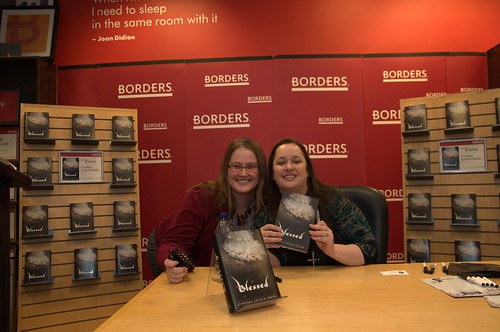
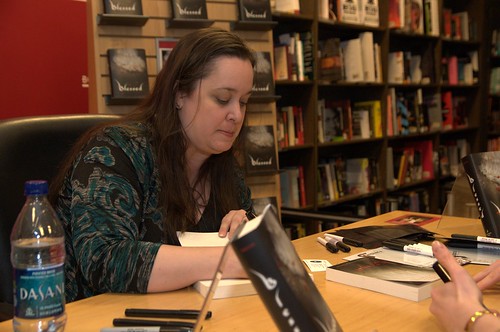
Originally published at Stacy Whitman's Grimoire. You can comment here or there.

By:
Stacy Whitman,
on 5/21/2011
Blog:
Stacy Whitman's Grimoire
(
Login to Add to MyJacketFlap)
JacketFlap tags:
publishing,
writing,
fantasy,
children's literature,
tu books,
tu,
science fiction,
community,
young adult literature,
diversity,
Add a tag
And finally, part 3. Read parts 1 and 2 here and here.
So now let’s talk about writing cross-culturally!
Writing Cross-culturally
A few months ago, I answered a reader’s question on my website, in which she asked, basically, “Is my character ‘black enough’?” which prompted a wide variety of responses, some voices expressing why the question itself hurt the readers, most particularly that the question comes with baggage that implies there’s only one way to be black. But much as it might be a painful process, with perhaps many mistakes made along the way, I think it’s important for us to be talking about writing cross-culturally. White writers have started to examine their privilege, have started to critically think about why they don’t include more diversity in their writing. So they start out with some incorrect ideas and a LOT of questions—and the way they ask the questions might not always be the best way to phrase something. Not to mention—getting back to that Le Guin quote that everyone has someone who is Other to themselves—that maybe black writers might be interested in Japanese culture, and East Asians might be interested in Indian culture, and all those intercultural interests that are so healthy for everyone to have.
It’s not the responsibility of your average POC on the street to explain Racism 101 to anyone who asks, and sometimes those responding have heard it ALL before. But there are ways for people who want to include a wider variety of people/cultures/ethnicities/races in their writing to figure out how to do so. In fantasy, sometimes it’s especially easy, because often our worldbuilding involves MAKING STUFF UP! If it’s not set in the real world nor directly influenced by it, why would everyone need to be white?
But then what about setting stuff in the real world, or in a world inspired by a specific culture, say, ancient China? That’s where research comes in. And as any writer knows, research means a number of different sources of information.
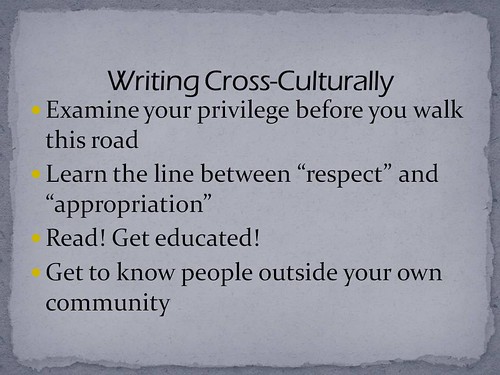
I know I’m going out of order here, but this really is one of the most important things someone who’s just starting out thinking about writing cross-culturally can do. And I don’t mean just walking up to a person on the street or a random work acquaintance and saying “so, tell me about you people.” If you don’t already know and trust someone from the culture you want to write about, ask yourself why that is—both that you want to write about it, and that you don’t know anyone. Then figure out how to fix the second part of that sentence. Find museums and cultural centers if you don’t know someone from that culture and ask them to point you in the right direction. It’s their job, at least, to field such questions, and it’s a better solution than asking the only black/Native American/Asian person you know. And besides, you can’t assume that if someone’s Asian, for example, that they’re from the culture you want to write about (BIG difference between Chinese/Japanese/Korean/other Asian cultures) or that they’d have any more experience than you do with it if they’ve lived here in the US their whole lives. They might. But they might not.
So USE YOUR LIBRARY. (Aside: Our libraries are under constant threat of budget cuts right now because of the economy. If you want to be able to keep using it as a resource—and you really should—make sure to also think about advocating for it in your communities/counties/states.)

By:
Stacy Whitman,
on 5/19/2011
Blog:
Stacy Whitman's Grimoire
(
Login to Add to MyJacketFlap)
JacketFlap tags:
science fiction,
community,
young adult literature,
diversity,
publishing,
writing,
fantasy,
children's literature,
tu,
Add a tag
See here for part 1.
Many authors have broken that mold & followed Ursula K. Le Guin’s admonition to write more of the “other.” But there’s still a strong British tradition—among the biggest touchstones for kids from the 70s and 80s era are arguably Susan Cooper, Roald Dahl, Diana Wynne Jones, etc.
All touchstones for a reason—they’re REALLY GOOD books. But told from a particular cultural perspective, and there is a danger to just one single story—and if you haven’t seen that TED talk by Chimamanda Adichie, I highly recommend you googling “the danger of a single story” and watching all twenty minutes of the talk, because she has a lot of really great things to say about how important it is for ALL children to see themselves mirrored in the books they read.
Yet despite our gains in diversity in fantasy and all of children’s books, we still have a long way to go. Just in the last few years, I’m sure you’ve heard of the problems with intentional or unintentional whitewashing that goes back as far as Ursula K. Le Guin’s A Wizard of Earthsea. You probably know that the main character of Earthsea, Ged, has copper skin, and that all the characters in the book except for the invaders are people of color. The myth was that “black books” don’t sell, so many versions of Earthsea didn’t feature people on the cover to avoid that “problem”—even to the point of featuring dragons. There are no dragons in Earthsea.

And when people were featured on the cover, what does Ged look like?
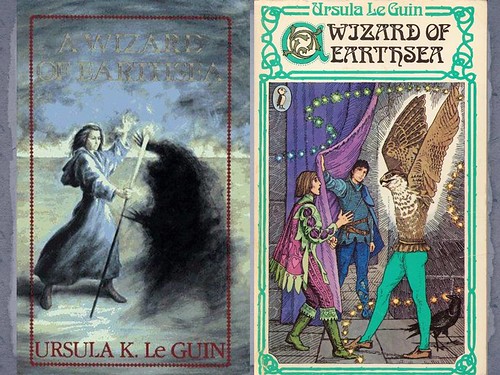
It’s easy to say that’s all in the past, but as we all know, we’re still dealing with the problem now.

There’s the question of whether “black books” sell to a “mainstream” audience (I hate this term, because “mainstream” here implies “white,” without the nuance of all the other people in the audience—74% isn’t 100%!), not to mention it assumes that white people wouldn’t be interested in reading a story that features a black (or Asian, or Native American, etc etc) character.
In a world in which Will Smith and Denzel Washington are doing just fine, why is this a problem in our books??
Several months ago I attended a panel that featured several NY publishing house editors, a School Library Journal blogger, and an NYPL librarian (sorry, it’s been so long I can’t remember who was on the panel, but someone who was there might pipe up). One thing that was brought up by someone (sorry! can’t remember who!) on the panel is that part of the problem is that we’re defining books by “black book”/“white book,” rather than “awesome mystery,” “exciting historical adventure,” “thriller,” “space adventure.” That’s what we�

By:
Stacy Whitman,
on 5/18/2011
Blog:
Stacy Whitman's Grimoire
(
Login to Add to MyJacketFlap)
JacketFlap tags:
tu,
science fiction,
community,
young adult literature,
diversity,
publishing,
writing,
fantasy,
cons,
geekiness,
children's literature,
Add a tag
Here you go! The first installment. Note that this was written to be spoken, so sometimes the diction might seem a little weird for a blog post. But I’m just going to leave it as-is, because you’ll get the idea.
Beyond Orcs and Elves: Diversity in Science Fiction and Fantasy for Young Readers
Ursula Le Guin, way back in 1975 said: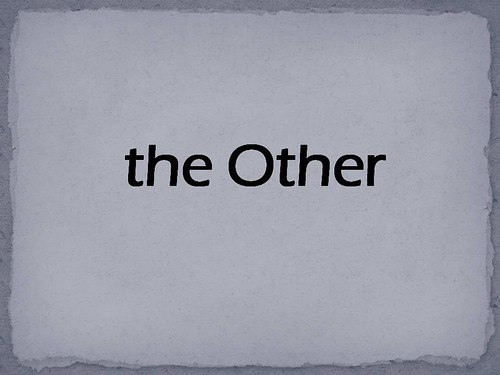
The women’s movement has made most of us conscious of the fact that SF [science fiction, but let’s include fantasy too] has either totally ignored women or presented them as squeaking dolls subject to instant rape by monsters—or old-maid scientists desexed by hypertrophy of the intellectual organs—or, at best, loyal little wives or mistresses of accomplished heroes. Male elitism has run rampant in SF. But is it only male elitism? Isn’t the “subjection of women” in SF merely a symptom of a whole which is authoritarian, power-worshiping, and intensely parochial?
The question involved here is the question of The Other—the being who is different from yourself. This being can be different from you in its sex; or in its annual income; or in its way of speaking and dressing and doing things; or in the color of its skin, or the number of its legs and heads.
 That was 35 years ago. (I know. I can’t believe it myself.) How are we doing today? I want to talk about the inclusion in speculative fiction for children and young adults of what 74% of the book-buying public might consider the Other in terms of mostly racial but also cultural differences. Perhaps this will help you in writing fantastic creatures or aliens, as well, this idea of writing the Other, but I want to focus on the human element today.
That was 35 years ago. (I know. I can’t believe it myself.) How are we doing today? I want to talk about the inclusion in speculative fiction for children and young adults of what 74% of the book-buying public might consider the Other in terms of mostly racial but also cultural differences. Perhaps this will help you in writing fantastic creatures or aliens, as well, this idea of writing the Other, but I want to focus on the human element today.
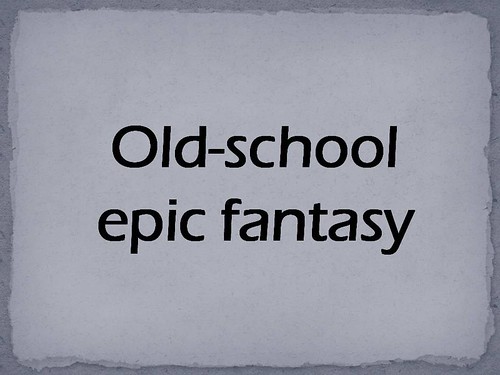
Old-school epic fantasy
- Campbellian monomyth (guys who start off their adventures in inns)
- ¨The British tradition”: Victorian fantasists to Tolkien & Lewis
- ¨My elves are better than yours”
- Dragonlance: The New Adventures
You may or may not know that fantasy as a genre started long before Tolkien was born. In fact, people have been telling fantasy stories for as long as there have been people. After all, the first fairy tales weren’t just what we now refer to as “myths,” creation stories and just-so stories. They were also fantastical tales told to pass the time or to warn children not to wander in the woods alone.
But let’s just start with the Victorian era, which had its own set of rules, morals and mores, body of literature, and cultural influences. We start with writers like George MacDonald, one of the primary influences on both Tolkien and Lewis, who wrote such tales as The Princess and the Goblin, The Light Princess, and The Princess and Curdie. His books drew upon fairy tales in their use of goblins, and they were fun, adventurous, and even allowed girls to have some adventure, whi
To hold you over until I can get my own talk up, here’s an even better talk by author Chimamanda Adichie, which I told everyone to go google, “The Dangers of a Single Story.” In it, she talks of how, when she was growing up in Nigeria (it was Nigeria, right? I need to go back and watch it again myself), the books she read most often (always?) featured white kids who ate apples. So when she started to write, she wrote stories about white people who ate apples, even though she had never seen an apple. A powerful talk about the importance of finding your own voice as a writer and how important to our body of literature a wide variety of voices is.
Originally published at Stacy Whitman's Grimoire. You can comment here or there.
Now that NESCBWI is over, I will be posting parts of my talk, “Beyond Orcs and Elves: Diversity in Fantasy & Science Fiction for Young Readers” here on my blog. I will be breaking it up over the course of several posts—it was designed as a 40-minute–to–hour-long talk, and it’s just too long for one post. Not to mention I have slides I’ll be putting up (someone suggested SlideShare? I’ll have to check it out once I have time to sit down with it) which need to be incorporated somehow.
I haven’t had time, though, to sit down and split up the talk and figure out where the most natural breaks are. I went straight from a busy week last week to a VERY full weekend Friday, Saturday, and Sunday (13 critiques and two presentations over the course of three days) to back to work on Monday, which has left me a little shell-shocked, and all I want to do now outside of work is to sleep. You know it’s bad when you can’t even concentrate on the Sarah Jane Adventures even though you’ve been looking forward to watching the last season!
My evening is full tonight, so it will be at least tomorrow night, if not sometime on Thursday (I’m taking the day off to be home for the delivery of my new couch, which I’m excited about) before the first post of the talk is organized. So keep an eye out until then.
Originally published at Stacy Whitman's Grimoire. You can comment here or there.
Awe. Some.
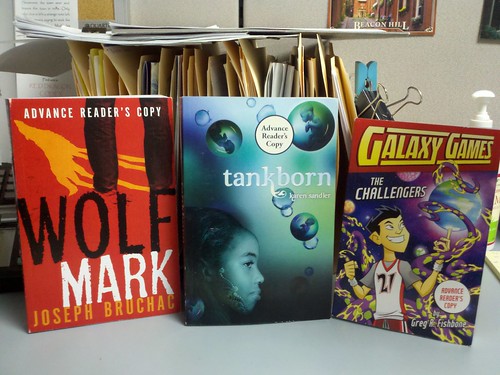
ETA: Oops, the uploading ability from my phone doesn’t seem to work with my blog—probably because my blog has been broken for over a year. In fact, old pictures I’ve uploaded have disappeared from the archives. So I’m using Flickr now. Anyone know an easy way to upload directly to Flickr from Android? I can’t find an app in the App Store, and I’m not sure which 3rd-party apps are reliable. Emailing it to myself, saving it to my computer’s hard drive, uploading it to Flickr, and THEN posting it here is too many steps!
Originally published at Stacy Whitman's Grimoire. You can comment here or there.
- Just got invited last minute to join a panel at ASJA on Saturday on “Perfecting Your Elevator Pitch” from 11 a.m. to noon this Saturday, April 30, at the Roosevelt Hotel in NYC. I believe it’s open to the public (not sure if there’s a cost) so if you’re going, see you there.
- Only a few weeks away from the NESCBWI conference in Fitchburg, MA, which I believe sold out, but if you were one of the lucky ones who got a ticket, I’m looking forward to doing a workshop on worldbuilding and a talk on diversity in fantasy in science fiction. I’ve given “Beyond Orcs and Elves” before, in California and in Utah, so this will be my East Coast version of it, and then after for those who didn’t make it to any of those events I plan on sharing at least parts of it on the blog here.
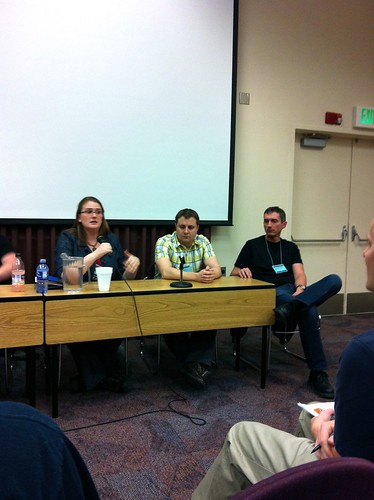 If you were to be in my worldbuilding workshop, what would you want to hear about? What kind of handouts would you find useful? I’ve done this workshop before, but it’s been a while and I’m working on updating it, so feel free to jot down a wish list. This is another topic that I’ve been meaning to blog more about, as well, so once the presentation/workshop is over I plan to share at least parts of it here.
If you were to be in my worldbuilding workshop, what would you want to hear about? What kind of handouts would you find useful? I’ve done this workshop before, but it’s been a while and I’m working on updating it, so feel free to jot down a wish list. This is another topic that I’ve been meaning to blog more about, as well, so once the presentation/workshop is over I plan to share at least parts of it here.
- While I’m in Fitchburg, I’m sad to say, I’m going to miss the Diversity in YA Tour stop in New York. Of COURSE all the cool things are happening on the same weekend! But that doesn’t mean that YOU have to miss out on it. They start the weekend after next with San Francisco, where friends Cindy Pon, Malinda Lo, and J.A. Yang will be signing (Cindy and Malinda are the masterminds behind the whole thing and will be at every stop), as well as Gene Luen Yang, who I don’t know personally but you heard about his National Book Award nomination for American Born Chinese or about the book winning the Printz and the Eisner. Then they’ll be in Austin, where they’re joined by a large contingency of authors including Lee & Low author Guadalupe Garcia McCall, whose debut Under the Mesquite comes out soon. And if you’ve read and loved Bleeding Violet as I did and are in the Austin area, Dia Reeves will be there, too, as well as several other notable authors. In Chicago, they’ll be joined by Nnedi Okorafor, among others. In Boston, you’ve got Holly Black, Francisco X. Stork . . . the list is getting too long. Just go to the tour page and look at all the cool people who will be at each stop! I will wave in Cindy and Malinda’s general direction as we pass, three ships in the night (or day as the case may be), me on the way to Massachusetts from New York City and them the other way around.
- Then later this month is BEA. I’m looking forward to seeing a lot of author friends in town. If you’re coming in town for BEA, drop me a line.
<
 I recently lamented that I had little blog fodder anymore—and of course I know you are all languishing to know what has been happening in my brain lately—and a friend suggested that I talk about the editorial process, because she didn’t know much about it. I have discussed it on this blog before, but my tag system isn’t the most organized filing system so perhaps it’s time to revisit the subject.
I recently lamented that I had little blog fodder anymore—and of course I know you are all languishing to know what has been happening in my brain lately—and a friend suggested that I talk about the editorial process, because she didn’t know much about it. I have discussed it on this blog before, but my tag system isn’t the most organized filing system so perhaps it’s time to revisit the subject.
This idea was reemphasized to me the other day when I got an email asking me (paraphrased and anonymized):
How would I go about getting a job like yours? I don’t have the discipline to write every day. I would love a job where I could read books all the time. Is there a way to become an editor instead of a writer without having to go back to full time education?
I like to joke that I get to read for a living, but the reality is that reading manuscript submissions is only a small part of my job, one that I constantly feel like I don’t have enough time to do. So here’s just a little window into the kinds of tasks I’ve been doing over the course of the last few weeks as I prepared and sent three books out to the printer for advance reader’s copies (and a few things I’ll be doing later this week). Some of these tasks only took a few minutes, some an hour, some took all day or several days, in the case of editing a manuscript.
- Meet with company vice president to go over a new-to-me procedure (in this case, several times, as this is our first season; this includes meetings about how to coordinate with the production manager, how to upload files to the printer’s FTP site, how to double check the files I received from the designers to ensure that what I’m sending to the printer has the correct measurements including bleeds, etc.)
- Check with marketing to ensure that the number of ARCs I’m telling the production manager we need is still correct
- Assemble all the specs of the ARCs to go along with the files I’m sending to the printer
- Compress PDFs for uploading to the printer
- Transfer zipped files to the printer’s site
- Organize feedback for partial revision that I’m asking author for to prepare for acquisition meeting
- Back-and-forth with author, including reading revision and clarifying some points
- Organize more feedback to refine partial revision for acquisition meeting
- Put together two acquisitions memos for the acquisition meeting, including market research, editorial notes, comparison titles, etc., and a trip to the library to find a particular book to show around at the meeting
- Go to acquisition committee meeting, present on why we need/want the books in consideration
- Email several agents about books in various stages of consideration
- Prepare offers for books discussed in acquisitions
- Negotiate with agents
- Prepare fall preview (visuals from my fall books) for department quarterly meeting
- Attend department quarterly meeting, talk about fall books briefly
- Attend company quarterly meeting, talk about fall books briefly
- Read full manuscripts that have been waiting too long for a reply (ongoing)
- Make a decision on whether to send feedback on certain full manuscripts
- Organize notes for manuscripts that I’m sending feedback on (ongoing, as I am working on several at once)
- Give partial submissions to intern to sort through and give feedback on to assist me in separating out the most promising submissions (ongoing)—which results in a pile of promising submissions I need to go through
Thanks again for everyone’s support with starting Tu Books! We’re closing in on getting our fall 2011 books out to the printer for advance reader’s copies, and we’ll soon have them available for reviewers and librarians at ALA. Summer is coming up fast!
Just to make you aware, if you linked to the tupublishing.com site at some point in the past before Lee & Low acquired it, we’ve had a redirect on it for the year-plus since I’ve been here in New York. The old domain name is set to expire soon, so please update your links to the current site if you haven’t yet done so.
Originally published at Stacy Whitman's Grimoire. You can comment here or there.
As I was walking through the muggy streets to work this morning, it was a little hard to breathe—it was threatening to rain but hadn’t quite gotten there yet. And that got me thinking about my asthma, and for some reason time travel along with it. Health/medical issues/immunity differences between time periods is a subject (are subjects?) that’s been talked about a lot in adult SF, but I haven’t really seen it addressed as much in science fiction for children and YA: Method of time travel aside, what would happen to someone who is extremely, say, allergic or asthmatic or something who had to travel in time? Sure, we generally want our heroes to be in good health so, y’know, they don’t die before the end of the book (and I’d truly worry that an asthmatic who doesn’t have access to modern medicine in the middle of a bad attack would end up dead or at least an invalid in most historic times—or would they? would certain cultures have treatments that would help?).
But could it be done? Could someone who had a condition that’s considered relatively minor and/or chronic today be the hero of a time-travel story? How would that be done in a way in which the condition presents challenges alongside the challenges of whatever the plot/mystery is—challenge them even to the point where there is a danger of dying, yet not actually die?
What say you, writers? Anyone ever do this story? Has anyone ever done it, that you can recall? I can’t think of any published time-travel books in which the main character has a medical condition that would present a danger in a historic time period. Can you?
Originally published at Stacy Whitman's Grimoire. You can comment here or there.
Dystopias are hot right now, that’s for sure. And I do love a good dystopia. After all, I’m a child of the 80s. Who doesn’t love The Terminator or Mad Max (especially the cheese of Beyond Thunderdome)? Or to use the example of a more present-day dystopia, space cowboys in Firefly? I love Joss Whedon, but his “shiny” futures (and presents) involve a lot of loved-character deaths, often in non-heroic, dystopian ways, and lately involving a lot of gunshot wounds to the head (I’m looking at you, Dollhouse). I call that dystopia.
But I’d like to see as much hope as I might despair. Oh, sure, dystopias often have a lot of hope, too—in fact, that’s probably one of the reasons I was frustrated with the last book of the Hunger Games trilogy, Mockingjay, because the end didn’t feel as hopeful as I wanted it to be. I feel like Matched by Ally Condie presents the possibility of a lot more hope—though we’re still waiting on book 2 and I could be wrong about that. And when your world is filled with zombie hordes, how much hope is left to the human race, let alone for any particular individual? I’m kind of scared to read The Dark and Hollow Places for this reason, though I’ve heard it’s really good. (And I loved books 1 and 2, so why am I so scared, even if it isn’t all that hopeful an ending?)
Science fiction is on a comeback slope, and most of it is dystopian. Yet kids, particularly, are all about hope for the future—even the teens who think we currently live in a dystopia hopefully have hope for their own futures, and plan to make the world a better place than the war-torn, disaster-filled world we’re living in right now. We need stories that address the hopeful side of life, as well, particularly in science fiction.
Farah Mendlesohn, a children’s book scholar, wrote an excellent Horn Book piece on this idea a couple years ago. While I don’t agree with her completely, she makes some great points (in my opinion, many of the old guard of SF don’t recognize children’s SF not because the writers aren’t SF experts, but because many old-guard SF writers still write as if it’s 1960 techwise—it baffles me that some of the old guard don’t recognize the genius that is Scott Westerfeld’s work as far as forward-looking tech, and I think addressing social concerns is vitally important too; not all science is hard science, says the social science major). (Equally important, though, is her point that many in children’s lit don’t understand the history of SF in children’s—those who don’t know who Norton and Heinlein are need to fix that problem!)
One point, in particular, is particularly important to my purpose here, though:
In their fiction for younger people, Heinlein, Norton, and their contemporaries wrote with an eye on concerns very similar to those found in adult science fiction: the world of work, the world of changing technology, and the bright new opportunities promised by these things. They could do this for two reasons. First, the world of teens was much closer to the world of adults than it is today. Norton and Heinlein’s audience was either already earning their own living or would be a few years in the future. Now the fifteen-year-old reader might be a decade away from the professional workplace. Second, Heinlein and Norton shared the values of the adult SF market and assumed that their role was to introduce younger readers to that material. They loved what teen SF readers loved: the bright shiny promises of the future.
…And perhaps because of YA literature’s preoccupation with social problems, science fiction for teens became increasingly a place for adults to warn the young about the future. At first glanc

By:
Stacy Whitman,
on 3/17/2011
Blog:
Stacy Whitman's Grimoire
(
Login to Add to MyJacketFlap)
JacketFlap tags:
science fiction,
young adult literature,
fantasy,
geekiness,
children's literature,
joseph bruchac,
genealogy,
tu,
greg fishbone,
fall 2011,
karen sandler,
Add a tag
We’ve got some exciting news over at the Lee & Low blog that you need to check out.
Also, for those who were interested in the African American genealogy conference, I promised I’d post my Top Ten Tips slides here and have gotten quite busy this week and haven’t gotten to it yet. I’ll post over the weekend. Thanks for your patience!
Originally published at Stacy Whitman's Grimoire. You can comment here or there.
I find I don’t want to blog much anymore, and mostly it’s because ever since my site broke, it hasn’t been quite right. I’m seriously thinking of giving up hosting it on my own (I can figure out most things, but it takes time I no longer have) and migrating my blog over to WordPress. A friend was showing me her site, and if my non-tech-savvy friend can get her site to look great there, maybe I should just use their infrastructure. Any more-tech-savvy-than-me friends know whether I can keep my custom headers and such while using WordPress’s servers rather than my own?
I’ll probably keep my own domain name, etc. The only thing that would change would be that my database would hopefully no longer be corrupted, and that I’d actually want to blog again because it wouldn’t be a headache every time I logged in!
Of course, that would require having something to blog about, and today I do have a little bit of a teaser for you. We’ve been working on the design stage of our Fall 2011 books, which means that we’re getting in preliminary cover art, looking at interior design, turning things around fast between designer, author, and editor (me). Within a few weeks I think we’ll have some final cover art to show off.
Like I said, just a teaser. Not much to talk about in public yet, but I can’t tell you how excited I am to finally show off the cool things I’ve been working on for almost a year. We’re working on acquiring for Spring 2012, too, so keep those submissions coming.
Speaking of Spring, I haven’t shared the acquisition we made last month here yet, have I? That’s how behind I am on blogging! Here’s the announcement we made in PW Children’s Bookshelf last month:
Stacy Whitman at Lee & Low Books has bought Bryce Moore’s debut novel Vodnik, for publication in spring 2012 by the Tu Books imprint. The YA fantasy tells the story of Tomas, a Roma boy who returns to Slovakia and discovers that the folk tale creatures he befriended as a boy are more dangerous than he knew, and he must strike a bargain with Death to save his cousin’s life. Eddie Schneider at JABberwocky Literary Agency brokered the deal for North American rights.
Originally published at Stacy Whitman's Grimoire. You can comment here or there.
View Next 25 Posts





















